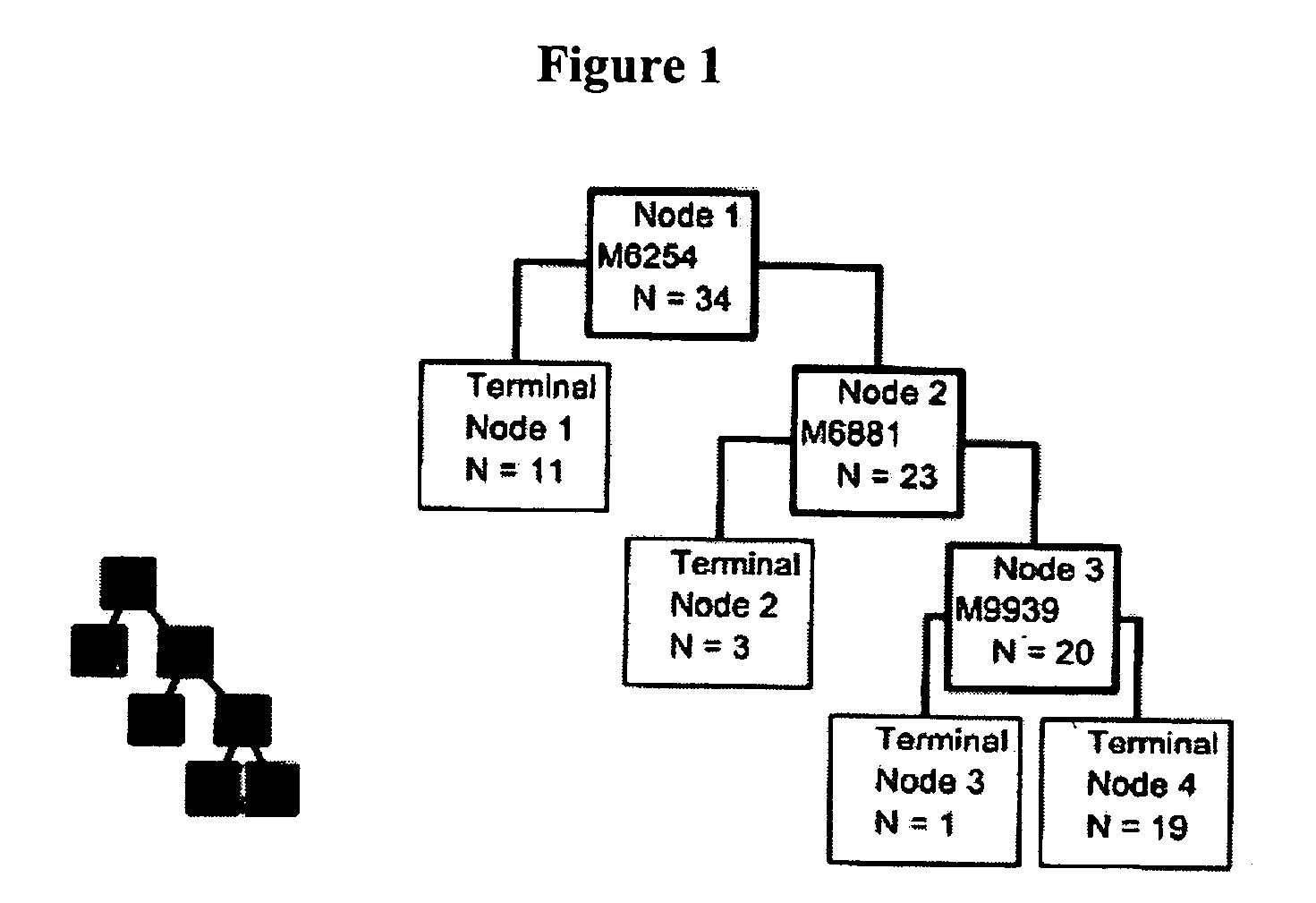Biomarkers for amyotrophic lateral sclerosis
a biomarker and amyotrophic lateral sclerosis technology, applied in the field of amyotrophic lateral sclerosis biomarkers, can solve the problems of no drugs that delay disease onset or prolong the life of als patients, no mutations, and no drugs that explain sporadic als (sals)
- Summary
- Abstract
- Description
- Claims
- Application Information
AI Technical Summary
Problems solved by technology
Method used
Image
Examples
example 1
[0046] This example demonstrates the identification of the mass spectral profile of proteins in cerebrospinal fluid (CSF) isolated from ALS patients.
[0047] The Ciphergen Bio Wizard Software version 3.1 was used to perform a univariate analysis of both the SAX2 and Zn-IMAC3 datasets to identify CSF spectral peaks that exhibit statistically significant peak intensities between the control and ALS subjects. A total of 366 peaks (207 on SAX2 chip and 159 on Zn-IMAC3 chip) were observed in the CSF samples and subsequently examined by the data analysis described above. As shown in Table 1, 51 protein peaks were identified from the SAX2 dataset that exhibited a statistically significant difference in peak intensity between control and ALS subjects (either increased or decreased expression levels). Many of these spectral peaks exhibited extremely significant p values (p<0.001). 43 spectral peaks also were identified from the Zn-IMAC3 dataset that exhibited a statistically significant diffe...
example 2
[0050] This example demonstrates the identification of a biomarker pattern for the diagnosis of ALS.
[0051] As described above, two different computer assisted algorithms were used to identify potential diagnostic biomarkers from the proteomic signatures of CSF from control and ALS subjects. The first algorithm was the Ciphergen Biomarker Patterns Software (BPS) package version 3.1. BPS creates classification trees containing one or more protein peaks that are used to predict disease status. An example of such a classification tree for the SAX2 dataset is shown in FIG. 1. The first peak used was at 6254 Da. The 11 patients with a peak value less than the cut-off are in the left node, of which 100% are ALS patients. The right node contains 23 subjects that were further split at a 6881 Da peak. Three subjects in the left node all were controls. The 20 subjects were then split at the 9939 Da peak, with 1 subject in the left node and 19 subjects in the right node. This classification tr...
example 3
[0055] This example demonstrates the identification of a protein biomarker present in the mass spectral profile of sample obtained from a human suffering from ALS.
[0056] CSF was collected from an ALS patient via lumbar puncturing as described above. To enrich the sample for biomarker identification, 500 μl of the CSF sample was fractionated by anion exchange fractionation using a Q HyperD column (Ciphergen Biosystems, Inc., Fremont, Calif.). Fractions were separated via stepwise elution and were collected at pH9, pH7, pH5, pH4, and pH3. Each fraction was analyzed by mass spectroscopy as described above to identify biomarker peaks of interest. Three biomarker peaks were identified in the pH4 fraction: a 6.2 kDa peak, a 13.3 kDa peak, and a 13.7 kDa peak. This fraction was concentrated using a YM-30 Microcon centrifugal filter (Millipore Corp, Billerica, Mass.). The flow-through was dried using a SpeedVac, resuspended in SDS-PAGE sample buffer (Invitrogen, Carlsbad, Calif.), and reso...
PUM
| Property | Measurement | Unit |
|---|---|---|
| mass | aaaaa | aaaaa |
| mass | aaaaa | aaaaa |
| mass | aaaaa | aaaaa |
Abstract
Description
Claims
Application Information
 Login to View More
Login to View More - R&D
- Intellectual Property
- Life Sciences
- Materials
- Tech Scout
- Unparalleled Data Quality
- Higher Quality Content
- 60% Fewer Hallucinations
Browse by: Latest US Patents, China's latest patents, Technical Efficacy Thesaurus, Application Domain, Technology Topic, Popular Technical Reports.
© 2025 PatSnap. All rights reserved.Legal|Privacy policy|Modern Slavery Act Transparency Statement|Sitemap|About US| Contact US: help@patsnap.com


